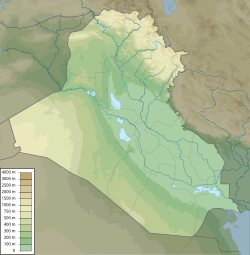Top Qs
Timeline
Chat
Perspective
Mosque of the Prophet Daniel, Kirkuk
Mosque in Kirkuk, Iraq From Wikipedia, the free encyclopedia
Remove ads
The Mosque of Prophet Daniel (Arabic: جامع النبي دانيال; Turkish: Peygamber Daniel Camii) is a mosque and mausoleum that is part of the Kirkuk Citadel territory, located in Kirkuk, Iraq. The mosque contains a shrine, in which local tradition affirms that Daniel and Shadrach, Meshach, and Abednego are buried in.[1] It is not only visited by Muslims, but Christians and Jews visit because of the graves of the Prophets, who are revered in all three religions.[2]
The mosque is one of several sites throughout the Middle East where it is claimed Daniel is buried, including the Tomb of Daniel, in Iran.[3]
Remove ads
History
The original structure was a synagogue which was converted into a Christian church. Local tradition relates that the church was converted into a mosque during the reign of the Caliph Umar ibn Abdul-Aziz. The present building dates from the start of the Timurid era to the end of the Ilkhanate. The mosque was also renovated by the Ottomans.[2] A cemetery for Ottoman soldiers who died during World War II was added at some point, and locals used the cemetery in subsequent years. It is the first cemetery in Kirkuk.
The mosque was used for worship, but this ceased in 1997 when demolition of the Kirkuk Citadel was proposed in order to migrate the Turkmen. However, the visits to the mosque and its shrine did not stop.[2] The mosque was reportedly neglected by local authorities,[when?] and some parts of the mosque collapsed.[1]
Remove ads
Architecture
The interior of the mosque is 400 square metres (4,300 sq ft). It has two blue domes and a single minaret. The minaret is made of brick and decorated with Qashani tiles, completed in the Ottoman style.[2]
The shrine
The mosque is also revered by the Christians and Jews of Iraq, who visit it to pay their respects to the alleged graves of the four Prophets within the mosque, who are Daniel, Shadrach, Meshach, and Abednego, the latter three who are given the names Hunayn, Mishail and Uzair[1] which are essentially Arabized versions of their Hebrew names Hananiah, Mishael and Azariah.
There are only three graves in the shrine. The location of the grave of Mishael is unknown.[1] The signboard for the grave of Abednego/Azariah misidentifies him with the biblical Ezra, also known as Uzair in Islamic tradition.
Gallery
- The rear of the mosque
- Inside the mosque, with the three tombs
- The tomb of Abednego/Azariah, spelled here as 'Ozuir'
- The tomb of Shadrach/Hananiah
- The temporary residence for the caretaker
See also
References
External links
Wikiwand - on
Seamless Wikipedia browsing. On steroids.
Remove ads








